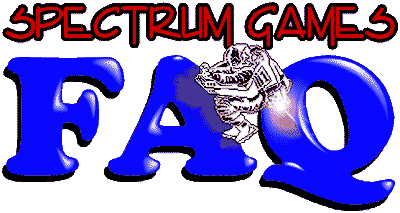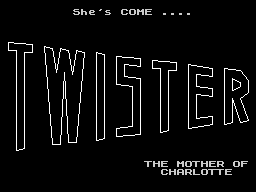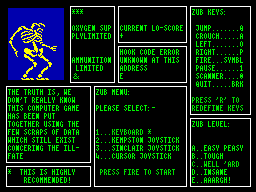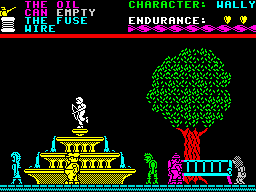

The June 1987 issue of SU reports that Mire Mare was still an ongoing project at the time. It was to be the next Ultimate game after Martianoids and Bubbler. Ultimate also reported that the game was to be followed by something they described as "Jetpac brought up to date". Maybe that last project was later canceled as Mire Mare was, or maybe it was taken over by the original Ultimate team to become the Jetman game on the NES.
One that's missing is Death Pit which was advertised by Durrell, I
remember a double page ad with screen shots and it DEFINITELY never came
out.
Staship by Jon Ritman and Bernie Drummon. The mysterious Pizza writes:-
I was just reading my old speccy magazines when an article about Jon Ritman and Bernie Drummond got my attention. In Your Sinclair Aug.'88 there's an article about JR & BD's game which was never released.More info can be found in the Sinclair Software Database.Quote: "A great loss, compounded by the fact that Starship (the name of the game) looks well impressive, even at the stage at which it reached before being abandoned. "The game that'll never be," Jon jokes as he loads it up. A flying saucer zooms along above a smoothly-scrolling tessellated landscape, a landscape that forms a globe and is complete with hills and mountains. The playing area is huge - flying at full pelt in one direction, you go for about 45 seconds before circling the globe. Starship had the makings of a great game - you wre going to be able to travel across the landscape in a variety of vehicles, hunting for treasures and entering buildings to buy and sell equipment. What a shame!"
Psyclapse and Bandersnatch (Psygnosis) were both never released. There was supposed to be a hardware add on to use them with and they were supposed to have amazing graphics including a caterpilla where each segment was animated individually (or something!)
Bandersnatch was Imagine's Speccy "mega-game" and was far from complete when the company went bust. Finchspeed sold the game rights to Sinclair Research and developed a complete QL version before folding -- Dave Lawson and Ian Heatherington then formed Psygnosis and the development team formed Denton Designs. The story was set in an inter-galactic nightclub on an asteroid, where buildings were linked by glass tubes across the surface. There were lots of interesting characters, including a fat bouncer (complete with bow tie) and a banana skin eating green worm (who inspired the green worm in Nodes Of Yesod), who communicated via speech bubbles. The game was a flip-screen arcade-adventure. The programming techniques (large sprites and flip screen special effects) and graphical style can be found in Denton Design's first game "Gift Of The Gods" (published by Ocean) -- as John Gibson (programmer) and Ally Noble (artist) worked on both games. Psygnosis revisted Bandersnatch for their first release, Brataccas (ST/Amiga). If you want to see Bandersnatch (minus the more original characters) load Brataccas into your ST/Amiga emulator.
Psyclapse was a C-64 "mega-game" by Imagine, but only really existed on paper before the company went bust. The only demo had the hero, wearing knee-high black boots, stomping along -- he was fixed in the centre of the screen (like Tir Na Nog) and a stoney wall background scrolled left and right. The hero was actually quite large by 1984 standards, using mutiple raster sprites. The story was about an evil villain who had transported warriors from throughout time to his fortress castle on a secret island, the object of the game was to escape.
Cyborg (CRL) - Was previewed in magazines around 1987 but never came to light.
Attack Of The Mutant Zombie Flesh Eating Chickens From Mars (starring Zippo the Dog) of course (Software Projects). Please see the SSD for more information, but the brief version is that it came out as Star Paws.
Solar Jetman (Rare). Came out on the NES only. See the Ultimate section for the full story.
Flashpoint (Ocean) was actually written but never released. It ended up on the cover of an issue of SU and also YS. I can see why they never released it. <- Opinion. Please ignore.
The Eye of the Moon, Mike Singletons sequal to Lords of Midnight and Doomdarks Revenge. I have no information on this. Can anybody help please?
Scooby Doo - well, IIRC it did actually get to the stage of being commissioned, and job being given to a programming company. They messed around with it for a while, actually beleiving that they could do it. When at last they realised that it didn't, they didn't tell Elite about it for a while. Eventually, it all collapsed and Elite had to start again and produced (IMHO) a fairly good game - the one that was released.
The original Scooby Doo was actually previewed in an issue of SU ( I believe ). It was originally scheduled to be a long interactive movie style thing, and looked really good. But they ran out of RAM. 8-) SU's ``Gremlin'' column jumped on this and started the ``Scooby Awards'' for delayed games.
Streethawk (Ocean) is a story all in itself. It was in fact released (very briefly) as part of a contract that Ocean had with a home shopping catalogue, Kays or something, but it was abysmal, and quickly changed for something else, although what, I don't know. The real StreetHawk was also properly released, although by then it was so late, nobody could remember who StreetHawk was, and it also didn't do very well...
The Siege of Earth trilogy by Gargoyle Games:
Part 1: Marsport
Part 2: Fornax
Part 3: Gath
Sadly, part 1 was of course the only one to actually appear. I don't believe the next two even began to get written.
The story, briefly, was as follows:
MarsportI got the above info from a Spectrum 128 promotional brochure which I still happen to own, which was (I think) given away with the computer when I bought it shortly after it was launched. The brochure details lots of games and hardware add-ons, including some games which never game out, such as Fornax and a 128K-only version of Dynamite Dan 2.The year: 2494. Earth is under seige by the ant-like Sept. The huge force-field protecting Earth is beginning to fade, and the original plans must be retrieved from the great city of Marsport, now occupied by the alien Sept... Commander John Marsh of the Terran Liberation Forces battles against the Sept Warlords and the robotic defences of M-Central in one last effort to reach the plans inside the Marsport City Computers.
Fornax
Fornax, the fire planet, is a world populated by Sept of the scientific caste, who are studying the ancient Star Lord civilisation with the help of mutated humans. The Terran Resistance must outwit the Sept brains and solve the enigma of the Star Lords in order to uncover the greatest secret of all - the location of the Sept Imperial planet, Gath.
Gath
(Story presumably never written...)
Other Gargoyle Games that were never written include the add-ons for Heavy on the Magik, more information on which is to come soon hopefully.
Beyond's Star Trek was the most famous Scooby award holder. It got to the mock-up screen shots stage and massive advertising, but nothing ever materialised of it. It was a very long running joke in Sinclair User.
I saw the Speccy conversion of 20th Anniversay Star Trek ST/Amiga game when I worked for Denton Designs. The 16-bit original was developed by ex-Dentonites and had extremely nice graphics (even by today's standards), however, the gameplay was not so hot. The third party 8-bit conversions didn't have the great graphics and were thus lame in the extreme -- it is absolutely no wonder that they did not see the light of day.
The Tebbit - This was a combined shot at Melbourne House's The Hobbit and British politics (I think the name was taken from Norman Tebbit, although his position in the government escapes me). Ads for the game appeared in computer magazines. If memory serves, there was one in the May 1983 issue of Personal Computer World. I later (about 1987, I think) read in another mag that the game had been cancelled.
Atomic Robo-Kid (Activision). The demo from YS was about 5 times slower than the coin-op. It was scrapped after Activision decided to shut up shop.
Then there is the Great Giana Sisters. I've been told that the game was never actually completed and that only beta versions of the game were reviewed.

Booty (Firebird) had a hidden game - it was a cheap'n'cheerful Scuba-Dive type game, but not nearly as sophisticated. To activate it you can either connect a Currah uSpeech unit, load the game, then wait for the attract mode to play all the way through, or try the pokes in the SSD. Anyway, then the diving game appears.
There is also a hidden game in Starfarce (Binary Design?), but accessing it is unknown at this time. It tells you in an old issue of SU, if anybody cares to look, and it's reckoned to be quite good.
There is also one in the Boggit (Delta 4). Apparently you type in "Delta 4" to get to it, but this must be in the second part (otherwise you get the message "Try again in part 2."). Unfortunately, to play part 2 you need to load a file from part 1, which is very difficult with a normal emulator. Does anyone have an "open" version?
 There is a hidden game in Zub 128 (Mastertronic) and you can see how to
access it if you go to pause mode. Pressing 2, 4, 6 and 8 will access the cheat,
while pressing 1, 3, 5 and 7 will access a hidden game called Light
Farce. However, this will only work with emulators that can read more than
two keys at once. This game is exactly the same as the game Zarjas that
appeared on the cover of Sinclair User, as part of their Megatape 1
compilation.
There is a hidden game in Zub 128 (Mastertronic) and you can see how to
access it if you go to pause mode. Pressing 2, 4, 6 and 8 will access the cheat,
while pressing 1, 3, 5 and 7 will access a hidden game called Light
Farce. However, this will only work with emulators that can read more than
two keys at once. This game is exactly the same as the game Zarjas that
appeared on the cover of Sinclair User, as part of their Megatape 1
compilation.
Everyone's a Wally (Mikrogen) had an Asteroids game when you entered the Public Telephone. It also had a Daley Thompson's Decathlon (Ocean) style sprint where you raced against a fish.
In fact Herbert's Dummy Run (Mikrogen) was riddled with them. There is rumoured to be a space invaders clone with Daleks for invaders, a breakout clone using the tennis raquet, etc.
All the "hidden games" in MikroGen games, ie Wally etc, were in fact essential parts of the main game, and you had to clear a certain number of waves of aliens, etc, before a certain task could be completed.
Short Circuit (Ocean) has a space invaders machine in one of the rooms that you can play, providing you have found the 1 pound coin to put in it. If I remember rightly you had to get the 10p coin from the plant tub somewhere and then play the hidden fruit machine that was somewhere else, then you'd win the pound coin so that you could go and play the Space Invaders machine.
Forbidden Planet (Design Design) had at least 2 hidden games, `Whino Hunt' which you got to by pressing lots of keys during the game, and a reasonably acurate space invaders clone which you got by holding down a key as the game finished loading.
The Prequel to Forbidden Planet, namely Dark Star (Design Design), had a sort of hidden game, except that it was more like a spoof of Teletext called Spectacle. It was accessed by loading the program on side 2 and typing in "everyone's a nervous wreck" (case important). This is available as a snapshot in itself with Issue 4 of Emulate. There is more information in the Spectrum Games Database entry.
 The Wally Games
The Wally Games
Automania, Everyone's a Wally,
Three Weeks in Paradise, Herberts Dummy Run, and Pyjamarama. All were released
by Mikrogen.
The Magic Knight Games
Finders Keepers, Spellbound,
Knight-Tyme and Stormbringer. All were released by Mastertronic, and programmed
by David Jones.
The Dizzy Games
Please see section
1.4. There's just too many to list again.
The Monty Mole Games
Wanted: Monty Mole, Monty On The Run,
Auf Wiedersehen Monty, Monty is Innocent, Impossamole and (maybe) Your Sinclair:
Moley Christmas. All were released by Gremlin Graphics.
The Horace Games
Hungry Horace, Horace Goes Ski-ing, and
Horace and the Spiders. All were written by Psion, mainly William Tang.
There was an early 1980s post-punk band from Leeds called the Delta 5, named after the Mekong Delta. A subliminal influence, perhaps.
These styles of games were used extensively by Ultimate. The first one, Filmation, was basically an isometric viewpoint, allowing virtual 3D movement. The best example of this kind of game is Knightlore (Ultimate).
Filmation 2 was slightly similar. Its main difference was that it allowed the screen to be scrolled, and also allowed the character to walk behind objects, which became invisible when necessary. However, the platform aspect of these games was greatly reduced compared to those using Filmation 1.
Windimation
This was the menu system employed is many of of Magic Knight games. Using the keys, the options could be scrolled through or highlighted, and various options would lead to more options. For example, selecting "Pick up" would then lead to a menu of other objects that can be picked up.
Your Sinclair had it's own scoring system, and it also created other systems for when reveiwing certain types of games, mainly for things like a "Flight Sim Special" or their famed "Crap Games Competition". Most of the points for these were out of 100, but the sub-scores were for variously strange aspects. For example (IIRC) Alien Frighteningness (or something). Hopefully a few posts to the group will improve my memory.
 Written by Stephen Smith.
mailto:stevo@REMOVE-THISjonlan.demon.co.uk
Written by Stephen Smith.
mailto:stevo@REMOVE-THISjonlan.demon.co.uk